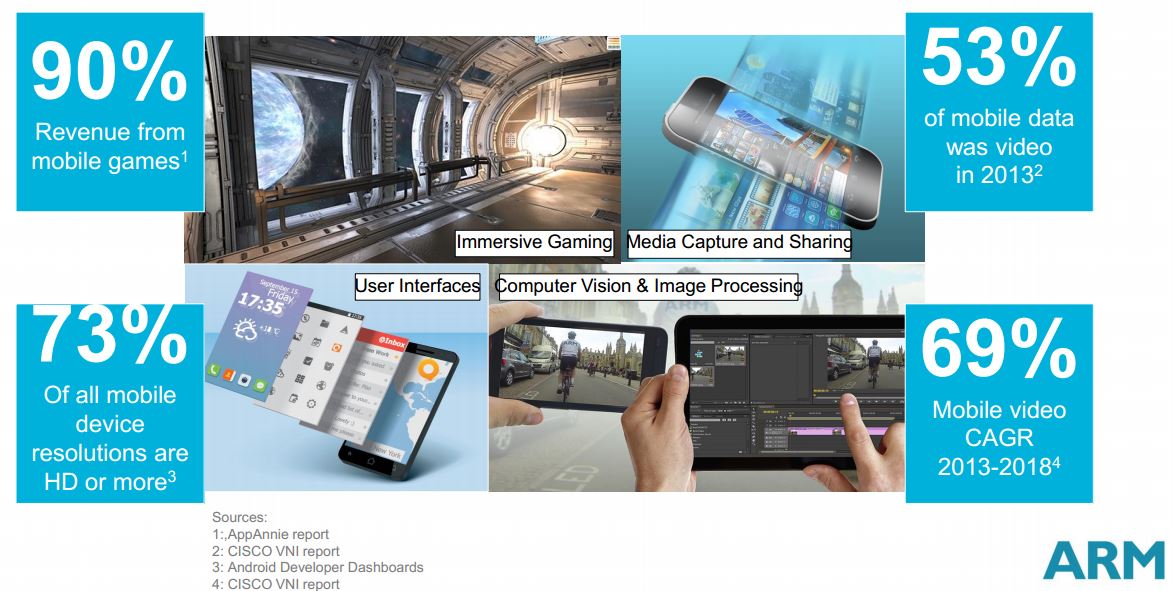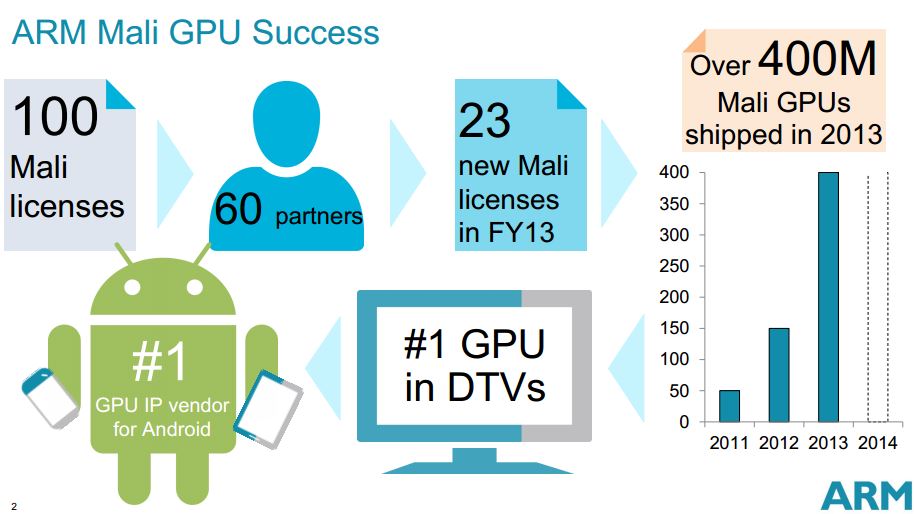ARM Announces Mali-T800 Series GPUs, New Video Accelerator And Display Processor, Too
Today, ARM unveiled three new GPUs, a video accelerator, and a display processor, all of which should start shipping in devices by the end of next year.
The new GPUs are the high-end Mali-T860, which is Mali-T760's successor (the GPU inside the Galaxy Note 4, International edition); the low-end Mali-T820, which is Mali-T720's successor; and finally Mali-T830, a new GPU for the mid-range that sits between Mali-T820 and Mali-T860.
Mali-T860
The new high-end Mali-T860 GPU is up to 45 percent more efficient compared to Mali-T628 (two generations before it), which should make it easier to scale up to its maximum of 16 cores. Its predecessor, the Mali-T760, was also scalable up to 16 cores, but so far it hasn't been used with more than eight cores, probably because that configuration used too much power for a mobile device.
The Mali-T860 will most likely appear in the Galaxy Note 5, or even the Galaxy S6 if Samsung gets early access to it. Either way, the reduced power consumption combined with Samsung's 20nm process (or even 14nm FinFET for the Note 5) should make it much easier to configure Mali-T860 with 16 cores in high-end mobile devices.
The new GPU also supports 10-bit YUV input and output (also supported by Android 5.0 now), OpenGL ES 3.1 and OpenCL 1.2. The OpenCL 2.0 standard was finished last year, and a conformance test was launched early this year, but it seems there wasn't enough time for ARM to support it in its new GPUs, even though they won't be shipping for another year. Mali-T860 will also support Android's RenderScript Compute and the full DirectX 11.1.
Mali-T820/Mali-T830
Get Tom's Hardware's best news and in-depth reviews, straight to your inbox.
The low-end Mali-T820 and the mid-range Mali-T830 seem to be very similar in design, with the main difference between the two being that the former has only one ALU/core, while the latter has two ALUs/core.
Both GPUs have 50 percent increased area efficiency and are up to 55 percent faster compared to Mali-T622, which is two generations older than the Mali-T820 and Mali-T830. Unlike the Mali-T860, both of these GPUs can only scale up to four shader cores. The two GPUs also support OpenGL ES 3.1, OpenCL 1.2, and RenderScript Compute, but only DirectX 11.1 FL9_3 (DirectX 9.3-level graphics API).
All three GPUs support the new ASTC highly scalable texture compression format and ARM's Frame Buffer Compression (AFBC), both of which lead to high bandwidth efficiency across the system.
ARM also utilizes other technologies such as Transactional Elimination (TE) and Smart Composition (SC) to avoid redrawing the same graphics again, if they remain the same. This could lead to improved battery life for devices because it will draw fewer UI elements, but it should increase performance in games as well.
Mali-V550
ARM also introduced the Mali-V550 video accelerator as a successor to the Mali-V500, which was launched last year. Both support 1080p60 on a single core, and 4k120 video playback on all eight cores, with the main difference being that Mali-V550 also comes with support for the new HEVC video codec and 10-bit YUV color depth, which increases the color precision by four times for the videos that support it.
Other new features supported by the Mali-V500 video accelerator are 50 percent system bandwidth reduction with AFBC and another 35 percent in bandwidth savings for Miracast streaming with Motion Search Elimination.
Mali-DP550
ARM also announced a new display processor called Mali-DP550, which is the successor of the Mali-DP500. The Mali-DP550 can do composition, rotation, scaling, post-processing and display output all in a single pass. It also supports AFBC and Motion Search Elimination just like the Mali-V550 video accelerator, which leads to low power and bandwidth usage.
ARM's Mali-DP550 can support composition of up to seven layers (unlike Mali-DP500 which could only handle three layers) and scales to 4k resolution. The display processor can interface with third-party SoC IP and can be customized with third-party algorithms by vendors, so they can differentiate their final products against their own competition.
The Mali-DP550 display processor supports all major display formats as well as a wide range of RGB/YUV pixel formats, including 10-bit YUV.
Putting Mali In Context
Imagination used to be the number-one GPU IP vendor, but it seems the popularity of ARM's CPUs, which are inside the vast majority of mobile devices, along with strong commitment from Samsung to use ARM's GPU IP in many of its products and a rise in popularity in China, have helped ARM to quickly catch up to and even surpass Imagination in market share.
ARM's Mali graphics licenses seem to have almost tripled every year for the past two years, from 50 million Mali GPUs shipped in 2011, to 150 million in 2012, to 400 million in 2013.
ARM will not restrict its CPUs to its own GPUs for the foreseeable future, especially when it gets so much business from companies like Apple, Qualcomm and even Nvidia. All three companies use different GPUs than Mali, as well as their own CPU cores. However, ARM has been working to make Mali GPUs as integrated as possible with its own CPU cores with features such as improved cache coherency between ARM CPUs and Mali GPUs and future support for heterogeneous computing.
This seems to have caused some concern for Imagination, which has acquired the MIPS architecture to create its own CPUs, which aren't even built on the ARM architecture. This could prove smart for Imagination in the long term, and it could even prove beneficial to smartphone customers if there are three ISA's competing with each other instead of only two.
There is also a strong trend for integration between the CPU, GPU and other co-processors that spans the entire chip industry, not just ARM's processors. AMD began taking advantage of this trend a few years back with its Accelerated Processing Units (APUs), and Intel has been going deeper with the integration between its CPUs and GPUs with each new generation.
For now, ARM's IP for different categories of chips continues to remain highly modular, and seeing as how ARM's main business is to sell IP to other companies, with some of them being its own GPU competitors (Imagination, Qualcomm, Nvidia, etc.), there's no reason to believe this will not continue.
ARM's open license business model has led to its own CPUs and its customers' CPUs based on the ARM ISA to dominate the vast majority of mobile devices. This is a winning strategy that ARM is unlikely to give up anytime soon, even as its own IP products start to gain more market share in the mobile chip market.
Follow us @tomshardware, on Facebook and on Google+.
Lucian Armasu is a Contributing Writer for Tom's Hardware US. He covers software news and the issues surrounding privacy and security.
-
bit_user I always thought it'd be cool if someone made a GPU out of ARM cores, similar to what Intel tried to do with x86 cores in its il-fated Larrabee. True, they did eventually come up with Xeon Phi, but it had long ago lost any aspiration of ever being a graphics card.Reply
I actually thought AMD might have been heading in this direction, when the ARM rumors first started bubbling up. It seemed like an interesting play to address GPGPU, if you could bolt big vector units onto a sea of comparatively simple in-order ARM cores.
Anyway, I wonder if anyone will ever build a desktop T-860 based graphics card. Seems unlikely, but I would consider buying one for the novelty and maybe to stick in a server box as a lower-power replacement for its current GPU.
-
anthony8989 I hate when they compare current chips to two or three generations old chips. What sense does that make?Reply
My smartphone is 1000x more powerful than the computers NASA used to land man on the moon. What relevance does that translate to?? -
anthony8989 I hate when they compare current chips to two or three generations old chips. What sense does that make?Reply
My smartphone is 1000x more powerful than the computers NASA used to land man on the moon. What relevance does that translate to?? -
anthony8989 I hate when they compare current chips to two or three generations old chips. What sense does that make?Reply
My smartphone is 1000x more powerful than the computers NASA used to land man on the moon. What relevance does that translate to?? -
aberkae So it seems that next Tegra based on maxwell cores will be most efficient and advanced with dx12 api compatibility and upto 2x performance per watt on same node.Reply -
aberkae So it seems that next Tegra based on maxwell cores will be most efficient and advanced with dx12 api compatibility and upto 2x performance per watt on same node.Reply -
aberkae So it seems that next Tegra based on maxwell cores will be most efficient and advanced with dx12 api compatibility and upto 2x performance per watt on same node.Reply -
aberkae So it seems that next Tegra based on maxwell cores will be most efficient and advanced with dx12 api compatibility and upto 2x performance per watt on same node.Reply -
bit_user Lol @ teh forum software: only 3 unique posts in 8!Reply
I know the server was having issues, yesterday. I got a double-post in another thread. -
bit_user BTW, mobile GPUs are important for enabling computer vision in your phone/tablet. It would be interesting to see benchmarks of some mobile apps that use GPGPU.Reply



